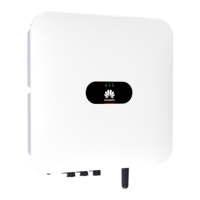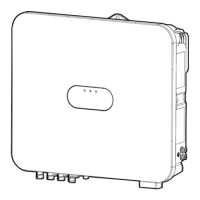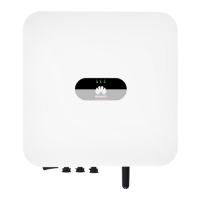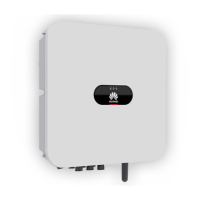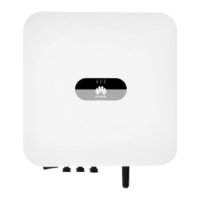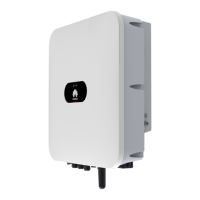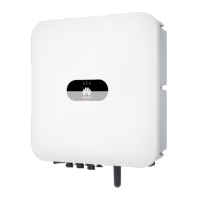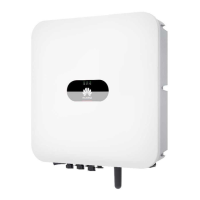Do you have a question about the Huawei LUNA2000-5-S0 and is the answer not in the manual?
Describes the LUNA2000 battery's overview, application scenarios, installation, maintenance, and specifications.
Identifies target users for this manual: sales, system, and technical support engineers, and end users.
Defines symbols used in the document for hazards (Danger, Warning, Caution).
Provides critical safety precautions for handling the equipment, including PPE and avoiding hazards.
Details electrical safety measures, including grounding, cable connections, and avoiding shocks.
Specifies environmental conditions for installation and operation, including temperature and humidity.
Covers safety precautions for moving heavy objects, working at heights, and handling the equipment.
Details critical safety guidelines for handling, storing, and using batteries to prevent hazards.
Outlines safety precautions and procedures for transporting the LUNA2000 battery.
Specifies conditions and precautions for storing the LUNA2000 battery to maintain its integrity.
Details grid-tied energy storage system configurations, including single inverter and cascaded setups.
Explains how to configure the grid-tied ESS modes: Max Self-Consumption, TOU, and Fully Fed to Grid.
Focuses on pure off-grid ESS scenarios where no grid is available.
Outlines networking for pure off-grid ESS, supporting single inverter configurations.
Guides setting the grid-tied and off-grid ESS mode, including enabling off-grid functionality.
Describes configurations for hybrid ESS, enabling power supply during grid instability or outages.
Details how to enable and configure off-grid mode for the ESS, including backup power settings.
Explains how to integrate LUNA2000 batteries with third-party inverters.
Covers pre-installation checks of outer packing, deliverables, and battery model.
Lists the necessary tools and personal protective equipment (PPE) for installation.
Provides requirements for battery installation location, angle, space, and structural integrity.
Details the procedure for floor-mounting the battery, including support installation and bolt tightening.
Details the procedure for wall-mounting the battery, including bracket installation and module securing.
Lists the types of cables required and their specifications, both customer-provided and supplied.
Explains how to connect internal PE cables, DC terminals, and signal cables within the battery.
Guides the installation of the internal PE cable to ensure proper grounding and safety.
Details the process of inserting positive and negative connectors for DC power within the battery.
Provides instructions for connecting internal signal cables between the power control module and battery expansion modules.
Covers external electrical connections, including battery cable connections and specific inverter types.
Details the procedure for crimping OT terminals and grounding the PE cable.
Guides the assembly of DC connectors and connection of power cables to the inverter.
Explains how to connect signal cables between the power control module and the inverter.
Describes how to connect batteries in series for increased capacity.
Details the final step of installing the external protective cover after electrical connections are made.
Lists essential check items and acceptance criteria before powering on the system.
Provides steps for powering on the LUNA2000 system and checking the running status via LEDs.
Guides the process of downloading the app, registering, and commissioning the battery.
Details system deployment, including connecting communication cables and adding batteries via the app.
Explains how to add a battery and set its control parameters and working mode via the FusionSolar app.
Describes how to check the ESS running status, battery level, and power via the app.
Covers procedures for forced charge/discharge, downloading upgrade packages, and battery maintenance.
Details the safe procedure for powering off the LUNA2000 system before maintenance.
Provides a checklist and intervals for routine maintenance tasks to ensure long-term operation.
Lists common alarms, their severities, possible causes, and troubleshooting measures.
Covers battery acceptance inspection, storage requirements, and conditions for judging overdue storage.
Explains why and how to recharge batteries with low state of charge (SOC) to prevent damage.
Describes how the system performs natural and forced checks to assess battery health (SOH).
Provides procedures for handling batteries that have been dropped or impacted, including safety warnings.
Details emergency procedures for dealing with battery smoke or fire, including evacuation and extinguishing methods.
Offers guidance for household members on how to respond to electric shock incidents involving PV devices.
Provides instructions for household members on how to handle battery leakage incidents and follow-up procedures.
Lists the technical specifications for the LUNA2000-5KW-C0 power control module.
Details the technical specifications for the LUNA2000-5-E0 battery expansion module.
Provides technical specifications related to SUN2000 inverters for different models.
Explains the procedure for replacing a damaged fuse in the SUN2000, including safety precautions.
Answers common questions about how the State of Charge (SOC) changes and why charging power might be low.
Provides guidance on checking cable connections if a battery upgrade fails.
Explains the options for immediate or delayed firmware upgrades via the FusionSolar app.
Guides users on how to contact local agencies for responsible battery recycling.
Details steps to commission a device before logging into the app, without internet access.
Explains how to commission a device after logging in, requiring connection to inverter WLAN.
Describes the LUNA2000 battery's overview, application scenarios, installation, maintenance, and specifications.
Identifies target users for this manual: sales, system, and technical support engineers, and end users.
Defines symbols used in the document for hazards (Danger, Warning, Caution).
Provides critical safety precautions for handling the equipment, including PPE and avoiding hazards.
Details electrical safety measures, including grounding, cable connections, and avoiding shocks.
Specifies environmental conditions for installation and operation, including temperature and humidity.
Covers safety precautions for moving heavy objects, working at heights, and handling the equipment.
Details critical safety guidelines for handling, storing, and using batteries to prevent hazards.
Outlines safety precautions and procedures for transporting the LUNA2000 battery.
Specifies conditions and precautions for storing the LUNA2000 battery to maintain its integrity.
Details grid-tied energy storage system configurations, including single inverter and cascaded setups.
Explains how to configure the grid-tied ESS modes: Max Self-Consumption, TOU, and Fully Fed to Grid.
Focuses on pure off-grid ESS scenarios where no grid is available.
Outlines networking for pure off-grid ESS, supporting single inverter configurations.
Guides setting the grid-tied and off-grid ESS mode, including enabling off-grid functionality.
Describes configurations for hybrid ESS, enabling power supply during grid instability or outages.
Details how to enable and configure off-grid mode for the ESS, including backup power settings.
Explains how to integrate LUNA2000 batteries with third-party inverters.
Covers pre-installation checks of outer packing, deliverables, and battery model.
Lists the necessary tools and personal protective equipment (PPE) for installation.
Provides requirements for battery installation location, angle, space, and structural integrity.
Details the procedure for floor-mounting the battery, including support installation and bolt tightening.
Details the procedure for wall-mounting the battery, including bracket installation and module securing.
Lists the types of cables required and their specifications, both customer-provided and supplied.
Explains how to connect internal PE cables, DC terminals, and signal cables within the battery.
Guides the installation of the internal PE cable to ensure proper grounding and safety.
Details the process of inserting positive and negative connectors for DC power within the battery.
Provides instructions for connecting internal signal cables between the power control module and battery expansion modules.
Covers external electrical connections, including battery cable connections and specific inverter types.
Details the procedure for crimping OT terminals and grounding the PE cable.
Guides the assembly of DC connectors and connection of power cables to the inverter.
Explains how to connect signal cables between the power control module and the inverter.
Describes how to connect batteries in series for increased capacity.
Details the final step of installing the external protective cover after electrical connections are made.
Lists essential check items and acceptance criteria before powering on the system.
Provides steps for powering on the LUNA2000 system and checking the running status via LEDs.
Guides the process of downloading the app, registering, and commissioning the battery.
Details system deployment, including connecting communication cables and adding batteries via the app.
Explains how to add a battery and set its control parameters and working mode via the FusionSolar app.
Describes how to check the ESS running status, battery level, and power via the app.
Covers procedures for forced charge/discharge, downloading upgrade packages, and battery maintenance.
Details the safe procedure for powering off the LUNA2000 system before maintenance.
Provides a checklist and intervals for routine maintenance tasks to ensure long-term operation.
Lists common alarms, their severities, possible causes, and troubleshooting measures.
Covers battery acceptance inspection, storage requirements, and conditions for judging overdue storage.
Explains why and how to recharge batteries with low state of charge (SOC) to prevent damage.
Describes how the system performs natural and forced checks to assess battery health (SOH).
Provides procedures for handling batteries that have been dropped or impacted, including safety warnings.
Details emergency procedures for dealing with battery smoke or fire, including evacuation and extinguishing methods.
Offers guidance for household members on how to respond to electric shock incidents involving PV devices.
Provides instructions for household members on how to handle battery leakage incidents and follow-up procedures.
Lists the technical specifications for the LUNA2000-5KW-C0 power control module.
Details the technical specifications for the LUNA2000-5-E0 battery expansion module.
Provides technical specifications related to SUN2000 inverters for different models.
Explains the procedure for replacing a damaged fuse in the SUN2000, including safety precautions.
Answers common questions about how the State of Charge (SOC) changes and why charging power might be low.
Provides guidance on checking cable connections if a battery upgrade fails.
Explains the options for immediate or delayed firmware upgrades via the FusionSolar app.
Guides users on how to contact local agencies for responsible battery recycling.
Details steps to commission a device before logging into the app, without internet access.
Explains how to commission a device after logging in, requiring connection to inverter WLAN.
| Model | LUNA2000-5-S0 |
|---|---|
| Category | Inverter |
| Rated Power | 5 kW |
| Communication Interface | RS485, CAN |
| Module Energy | 5 kWh |
| Usable Energy | 4.5 kWh |
| Nominal Discharge Power | 2.5 kW |
| Nominal Voltage (Single Phase / Module) | 360 V |
| Protection Level | IP65 |
| Cooling | Natural Convection |
| Battery Cell Technology | Lithium Iron Phosphate (LFP) |
| Operating Voltage Range (Single Phase / Module) | 350 - 560 V |

